In this post I will go over an approach to getting developers familiar with, and write code against LLMs. The aim is to get developers comfortable interacting and programming with LLMs. It is only a starting point; it’s not meant to be in depth in any way, nor will it cover the inner workings of LLMs or how to make your own.
For this tutorial you will need access to a commercial off-the-shelf LLM service, such as OpenAI Playground, Azure OpenAI, or Amazon Bedrock; in my examples I will be referencing OpenAI’s playground but the others will have similar functionality to follow along.
You’ll also need a Python notebook, which can be a service like Google Colab, Paperspace Gradient, or locally in VSCode afresh, or in my sample notebook.
I’ll first start with some direct LLM interactions, as these help to provide a base understanding of what’s happening behind the scenes. From there we’ll build up to the actual programmatic interaction in Python.
Clarifying some terms
It helps to be familiar with some of the words that are used in this area. Some are pure marketing, and some have specific meanings.
AI is supposed to be the branch of computer science aiming to enable machines to perform intelligent tasks. It has now been coopted by mainstream media and is additionally employed as a marketing buzzword. It is used to describe any sufficiently advanced technology that wows people, which they don’t understand. As an example, text to speech conversion (dictation) was referred to as AI when it first came out decades ago, but is now a commonplace aspect of many application interfaces.
Machine Learning is a subset of AI (the field) that focuses on the development of algorithms and models to enable the performance of specific tasks, like predicting the weather, or identifying a dog breed from a photograph. It is a well established and mature field.
Large Language Models, or LLMs, are a specific type of model that have been trained on a large amount of text data, to understand and generate natural language as an output. LLMs have been gaining a lot of media and business attention in the past few years. Well known LLMs are GPT by OpenAI, Claude by Anthropic, and LLaMa by Meta.
Image generation models, are also gaining attention, these can generate an image based on a text description, in various styles and degrees of realism. The most well known systems here are Dall-E, MidJourney and Stable Diffusion.
In the same vein, there are models for music generation, video generation, and speech. The collective term for these content creation models is Generative AI, often shortened to GenAI.
Of the many types, LLMs get a lot of attention from businesses, research, and hobbyists, because they are very easy to work with. It’s simply text input and output, and there are a lot of techniques emerging to optimize working with them.
Text completion and temperature
In the LLM playground, switch to the completions tab. Completions is as close as it gets to the raw interface of an LLM, it only needs some text and some additional parameters.
Give it any sentence fragment to begin with, like
Once upon a time,
and let it generate text. It might appear a little nonsensical, but the LLM simply produces what it thinks should come next after the given fragment.
Try a few more fragments, which can be quite revealing.
The following is a C# function to reverse a string:
See how it produces the C# function asked for, but carries on producing output (such as how to use the function, or the same function in other languages), until it reaches the maximum length. The takeaway here is that an LLM is not a chatbot out of the box. Think of an LLM as a very good autocomplete tool, for some given input text it has a decent idea of what should come next. It’s up to us to shape the LLM to get it to produce useful output.

Try adjusting the temperature slider now, and see how it affects the output. Try the following prompt at temperature = 0 and then at temperature = 1.
The sky is blue, and
Temperature influences the randomness of the model’s output; at higher temperatures the generated text is more creative, and at lower temperatures it’s more focused. When programming against LLMs, using low temperatures is better if a more deterministic, repeatable output is needed.

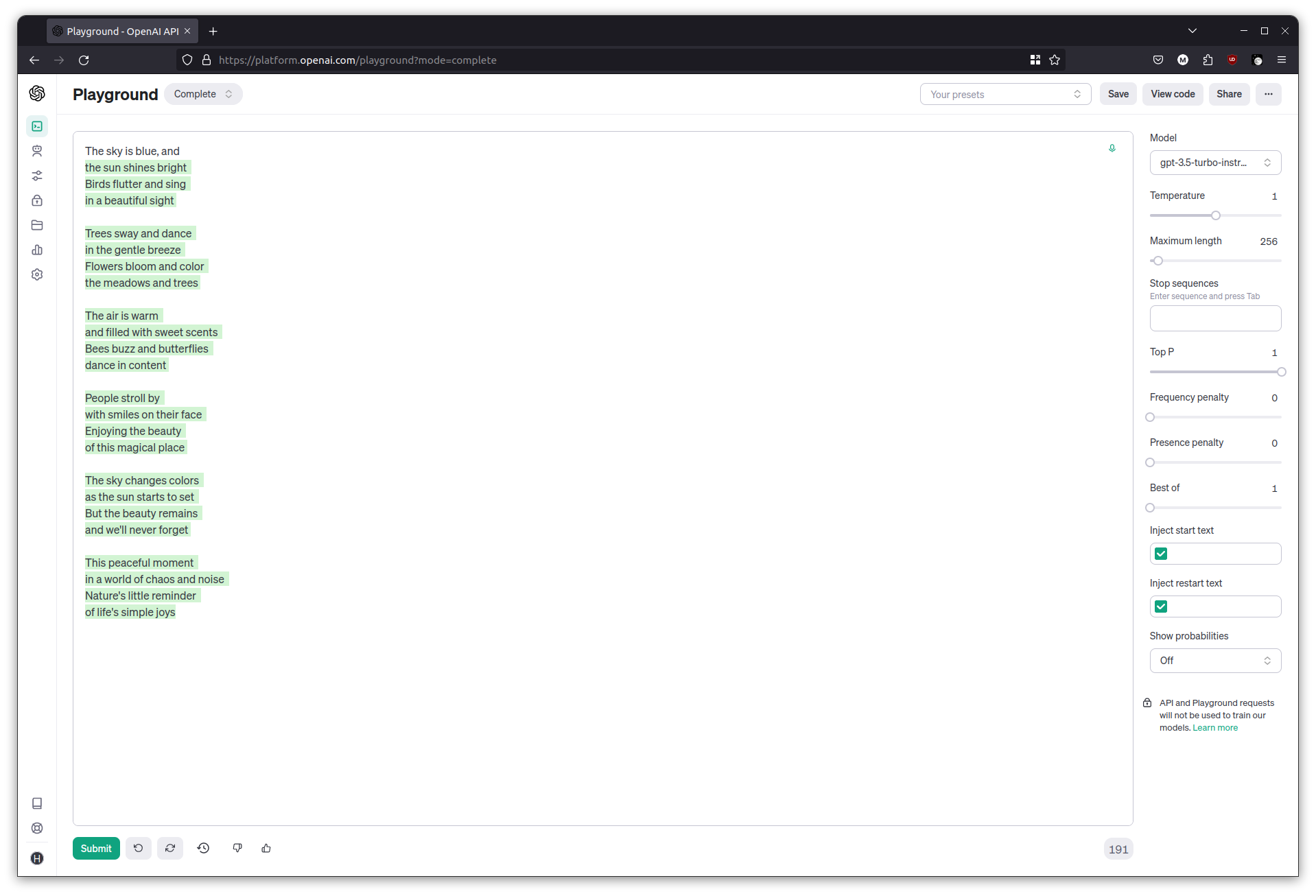
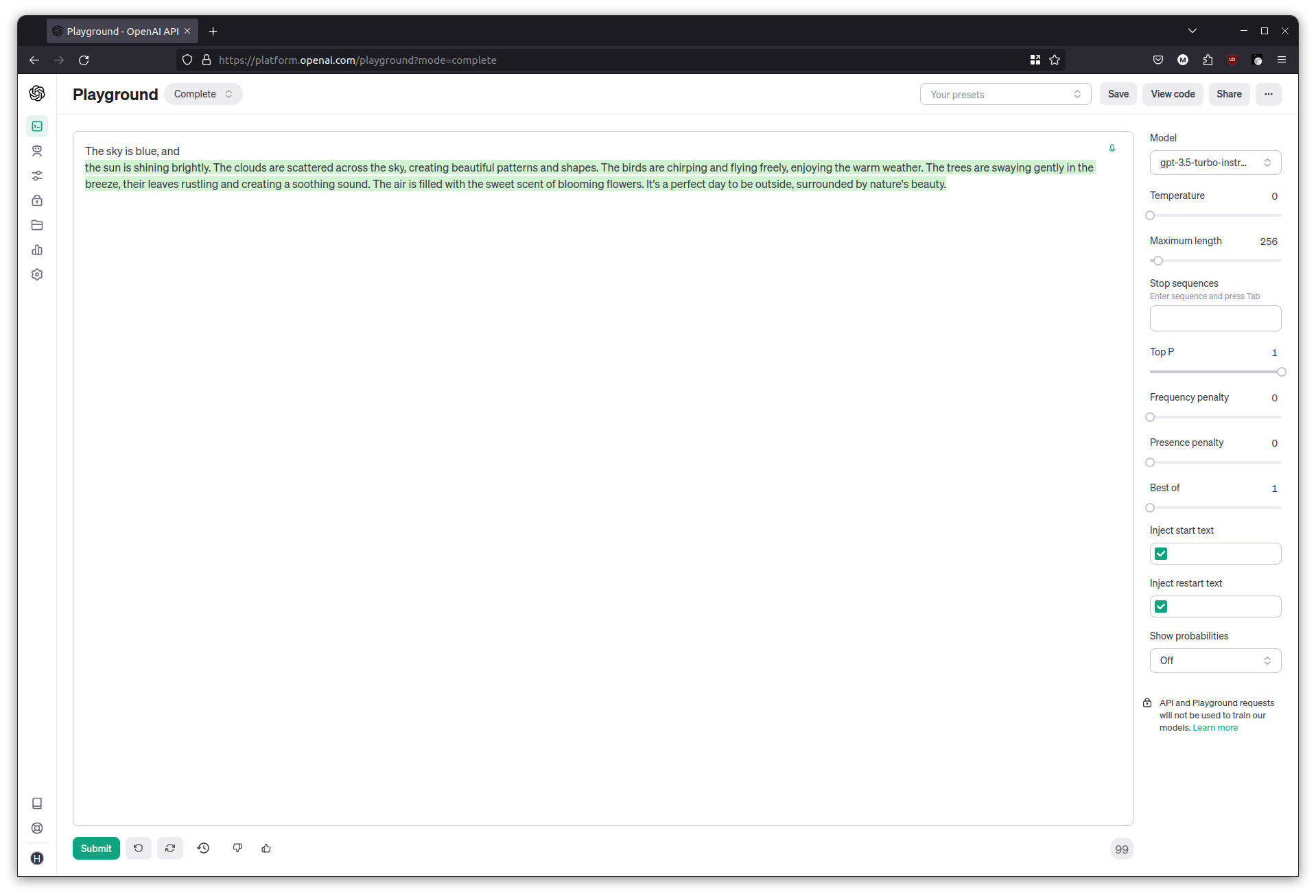
Tokens and context
Tokens are mentioned frequently in LLM interfaces, conversations, as well as pricing.
Tokens are the units of text that the models understand. They are sometimes full words, and sometimes parts of words or punctuation. The best way to see for yourself is to try the OpenAI Tokenizer and try the example.

Notice that some words get split up, some characters that often appear together are grouped up, and some punctuation marks get their own token. There is no exact conversion between tokens and words but the most common idea is to consider on average 4 to 5 characters as be a token.
LLMs come with a maximum token context or context window. Think of it as the number of tokens that the LLM can deal with while still (kind of) being effective at its predictions. The token context includes the input prompt, the output from the model, and any other role-setting or historic text that has been included. LLMs come with a limited token context depending on the model.

Some well known LLMs and their limits:
- GPT 3.5: 16k tokens
- GPT 4: 32k tokens
- GPT 4 Turbo: 128k tokens
- Claude v2: 100k tokens
- LLaMa2: 4k tokens
It’s tempting to think that the 100k+ LLMs are the best for being able to handle so much at once, but it’s not a numbers game. In practice, LLMs start to lose attention when it has to deal with too much input, it ‘forgets’ what the important parts of the initial input were, and results in poor or distracted output.
Chatbots are just completion with stop sequences
While still in the Text Completion playground, switch to another model such as davinci-002. Since it isn’t made for Q&A type tasks, it is better for illustrating the next concept.
Begin with a conversational type input like this:
Alice: Hi how are you?
Assistant:
and hit generate. In many cases, the text completion produces an output for the Assistant, but carries on the conversation for Alice as well. This is the same principle as before, essentially, producing what a chat transcript could look like between these two characters.
Now add a Stop sequence to the parameters in the completion interface. Add Alice: then repeat the above exercise. After each response it will stop instead of producing the next Alice:. Carry on the conversation by having Alice ask another question, and then end each new input with Assistant:, to let the assistant fill its part in.
Alice: Is everything alright with my account?
Assistant:

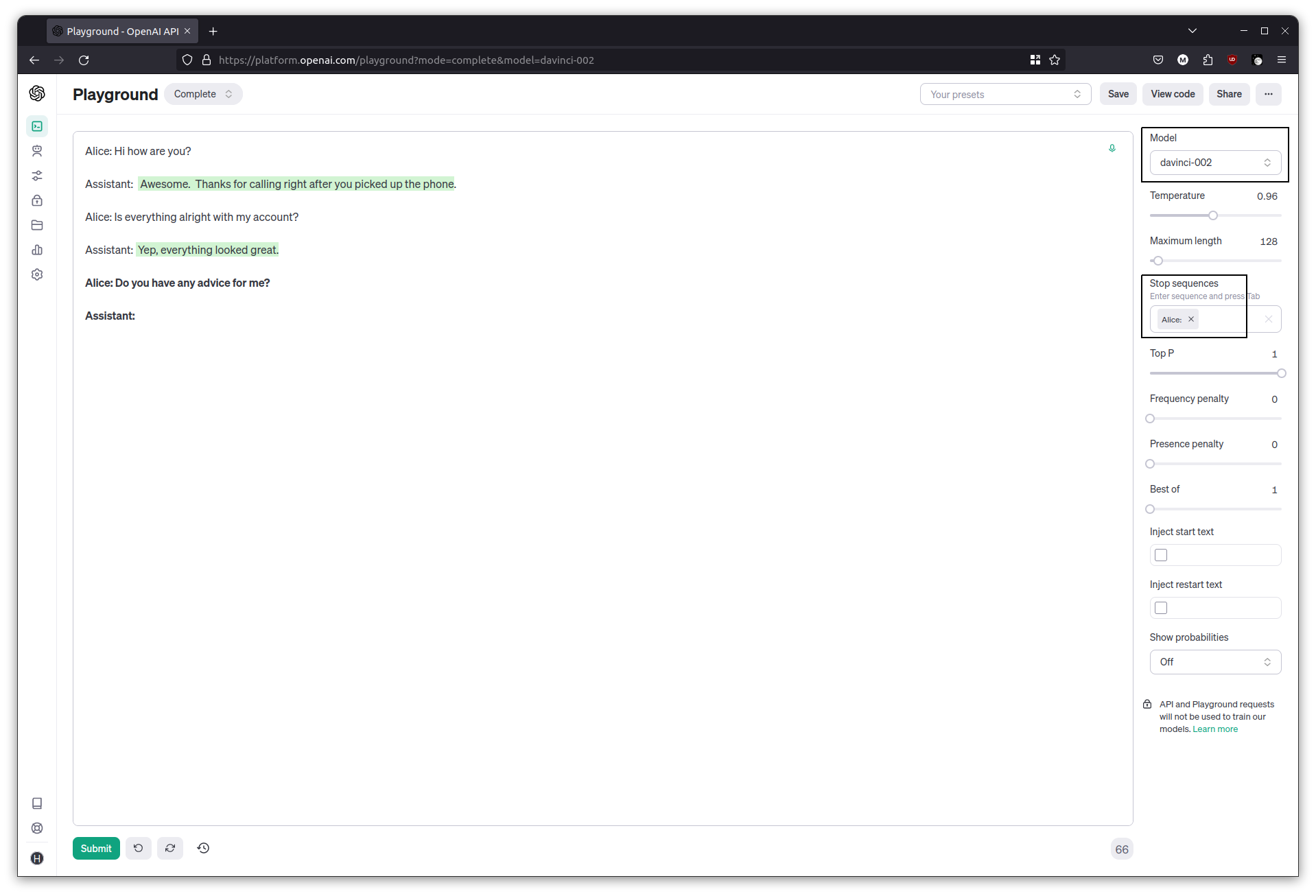
That’s a rudimentary chatbot. Each time we hit generate, the previous conversations (the history) are being sent, along with the latest input. The model produces an output until it hits the stop sequence.
Using a chat interface
Switch to the Chat playground. From what we’ve learned so far, it should now be a little more obvious how the chat based interface is working behind the scenes. The chat interface is the one most people will be familiar with, through the well known examples of ChatGPT and Claude. It is also the interface that most LLM programming is written for, as it is tuned for Q&A type work.
Chat with history
Try a simple exercise. Ask it for a joke, and then ask for an explanation.
Tell me a joke
Explain please?
The chat interface retains history, so the previous question and answer are included in the input when the explanation was requested. This history retaining feature is a useful and natural part of chatbots, but do keep in mind that it uses up some of the context window.

Summarizing news
A common task with LLMs is to ask it to summarize something. Grab a news article from anywhere, and copy its contents. Ask the chatbot to summarize the news article. The models are pretty good at sifting through irrelevant bits in between too.
Summarize the following news article:
<paste the news article here>

Answering questions
You can also ask the LLM to answer a question for a given text. Grab the contents of this article about an asteroid, and ask it a question about where the best locations would be to view it.
Given the following news article, answer the question that follows.
Article: <paste the news article here>
Question: What are the best locations to see the asteroid?

Context and reasoning with a chatbot
Remember that chatbots work with a context, and based on the additional hints and information that it is given, it can generate text to fit that scenario.
Try the following input with the chat interface.
Complete the sentence. She saw the bat ___
The output I got was alluding to the mammal: flying through the night sky.
Clear the chat then try this.
Complete the sentence. She went to the game and saw the bat ___
This gave me a completion about a bat of the wooden variety: She went to the game and saw the bat hitting home runs.
The ability to understand an input and respond, with some given context, makes LLMs appear as though they can be used for reasoning. This is considered an emergent property of its language skills, and at times, it is able to do a decent job.
You can ask the chat interface to emulate reasoning by adding a “Let’s think step by step” at the end of a question.
Who is regarded as the greatest physicist of all time, and what is the square root of their year or birth? Let's think step by step.

This doesn’t always work well though. With the following example from LLMBenchmarks,
Sally (a girl) has 3 brothers. Each brother has 2 sisters. How many sisters does Sally have? Let's think step by step.
I was reliably informed that Sally had six sisters.
As amusing as the answer is, it’s a contrived example of the dangers that LLMs come with. It has produced a reasonable looking passage of text that seems to answer the question, but it can be wrong, and it’s really on us to verify it.

Shaping the response
So far I’ve only been showing basic interaction with LLMs. For programmatic interactions, it’s important to get the LLM to produce an output that can be worked with in code. It is most common to ask it to output a single word, or something structured like JSON or XML.
Let’s make the chatbot help with chemistry related questions. We want it to tell us the atomic number of a given element that the user mentions.
Clear the chat and set the temperature to 0. Start by asking it to produce only the atomic number, and then follow up with some more element names.
What is the atomic number of Oxygen? Respond only with the atomic number.
What about Nitrogen?
Tell me about Helium
The LLM can get distracted quite easily and go back to its chatty mode, which isn’t great for programmatic interaction.
System Messages
A good way to deal with this is to give it a ‘role’ to play, known as the system message. This message gets added right at the beginning of the input to the LLM, which sets the context for the rest of the conversation.
Clear the chat messages, then in the System prompt area, add the following:
You are a helpful assistant with a vast knowledge of chemistry. When the user asks about an element, respond with only the atomic number of the element. Do not include additional information.
Try the same questions as before, and the responses should be more consistent this time.
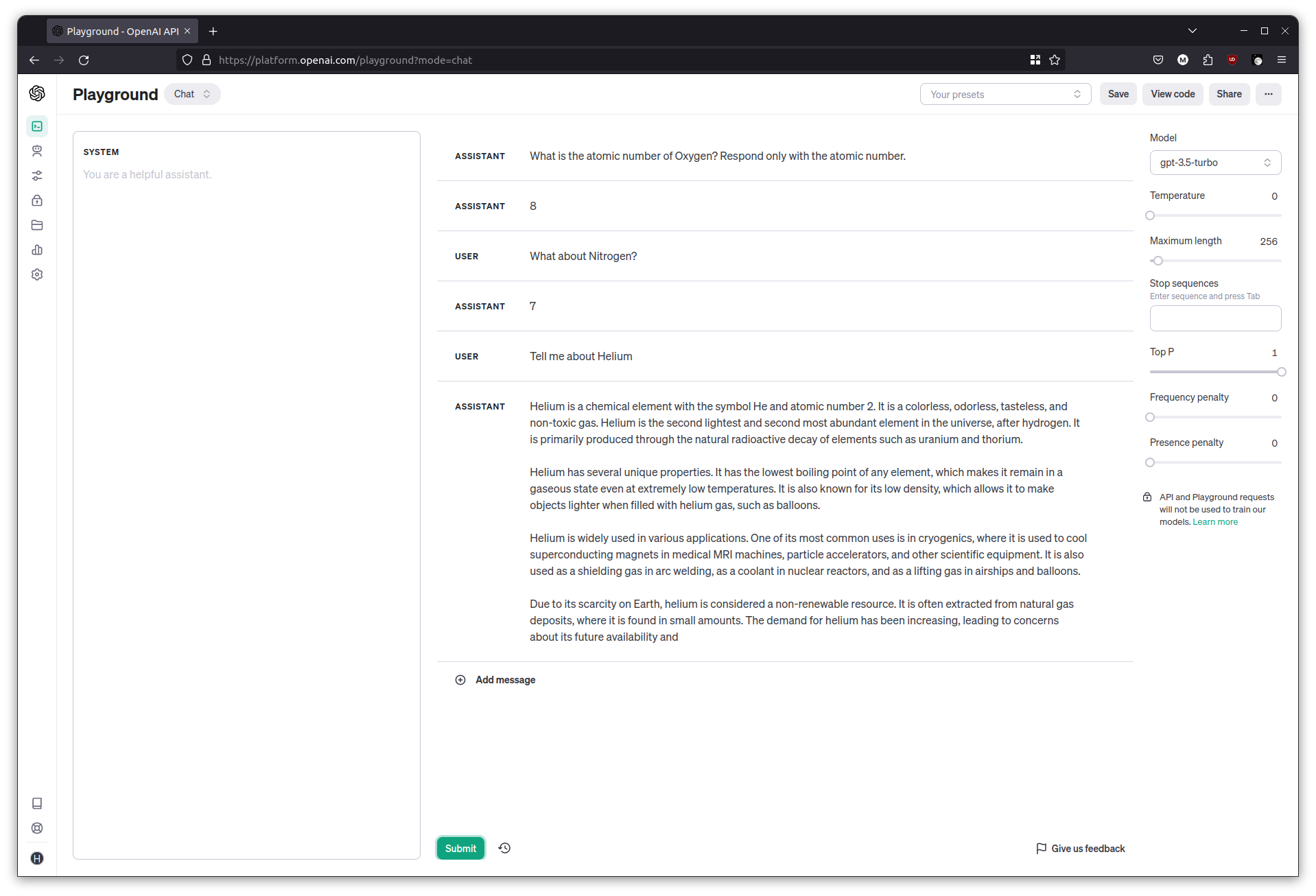
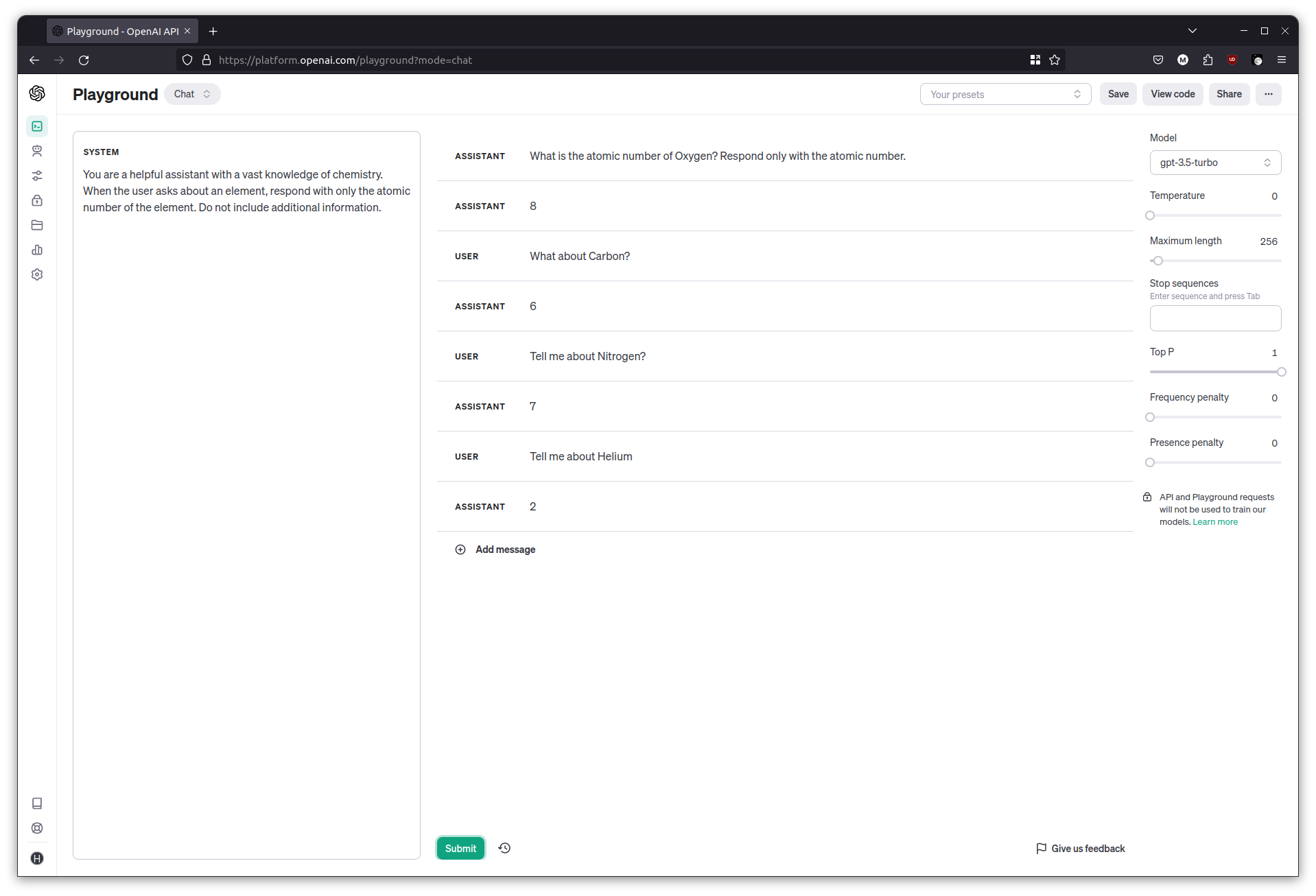
Giving the LLM examples to learn from
This time, we’d like the chat interface to produce JSON output so that it’s easier to work with in our code. Start by modifying the system message and simply asking for some JSON.
Clear the chat, then in the System prompt area:
You are a helpful assistant with a vast knowledge of chemistry. When the user asks about an element, respond with the chemical symbol, atomic number and atomic weight in a JSON format. Do not include additional information.
Try asking about some elements and it should respond with some JSON, I got an output like {"symbol": "V", "atomic_number": 23, "atomic_weight": 50.9415 }
Although the LLM made up the JSON key names, there’s no guarantee it will always use those key names. We want to control the JSON key names and have the LLM follow our schema.
This is where examples come in. In the System prompt area, it’s possible to provide a few examples to get the LLM going, and then any subsequent answers it produces should follow those examples. This technique is known as Few Shot Prompting.
Clear the chat, then in the System prompt area:
You are a helpful assistant with a vast knowledge of chemistry. When the user asks about an element, respond with the chemical symbol, atomic number and atomic weight in a JSON format. Do not include additional information.
Examples:
User: Tell me about Helium.
Assistant: {"sym": "He", "num": 2, "wgt": 4.0026}
User: What about Nitrogen?
Assistant: {"sym": "N", "num": 7, "wgt": 14.0067}
Try the questions once more and observe as the JSON keys match the examples.
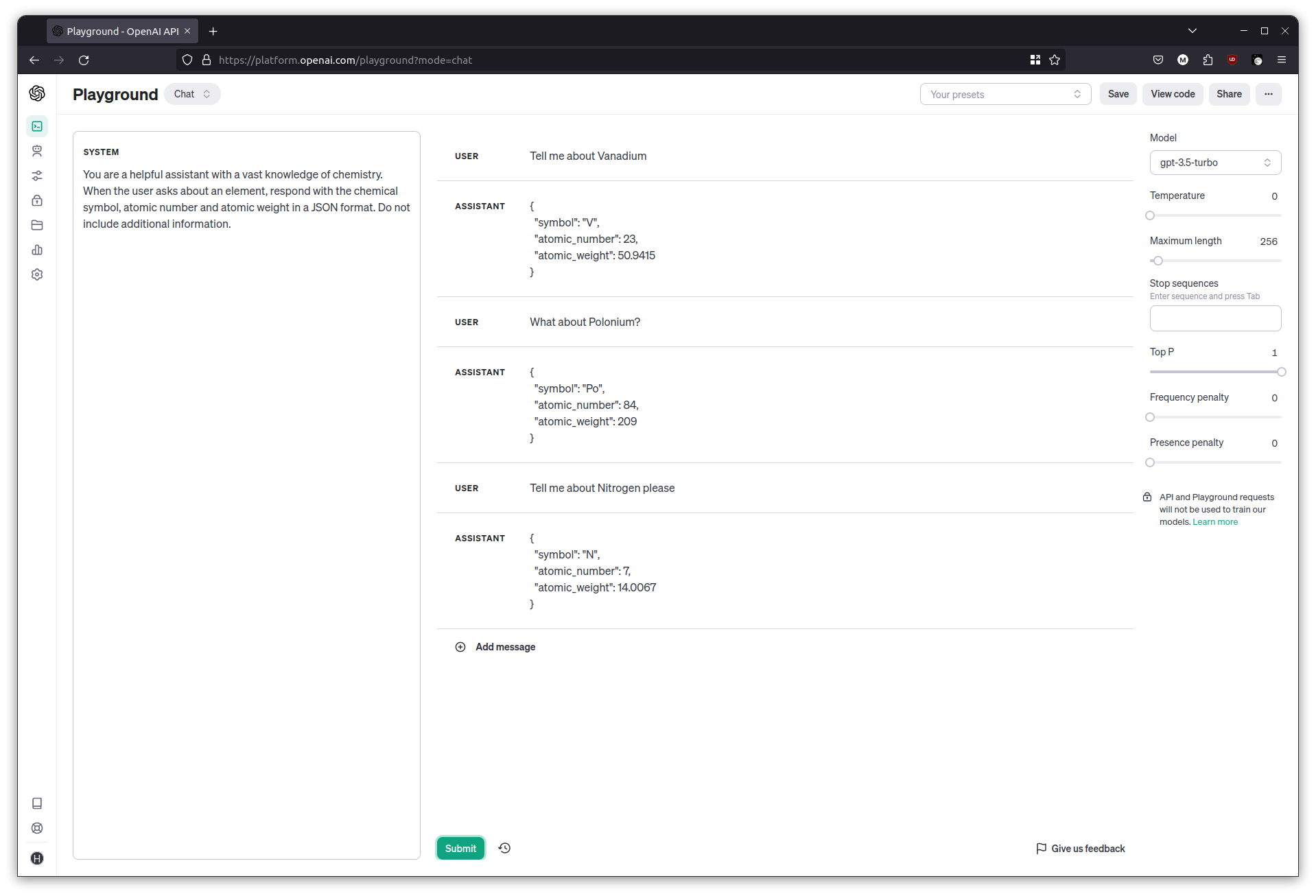
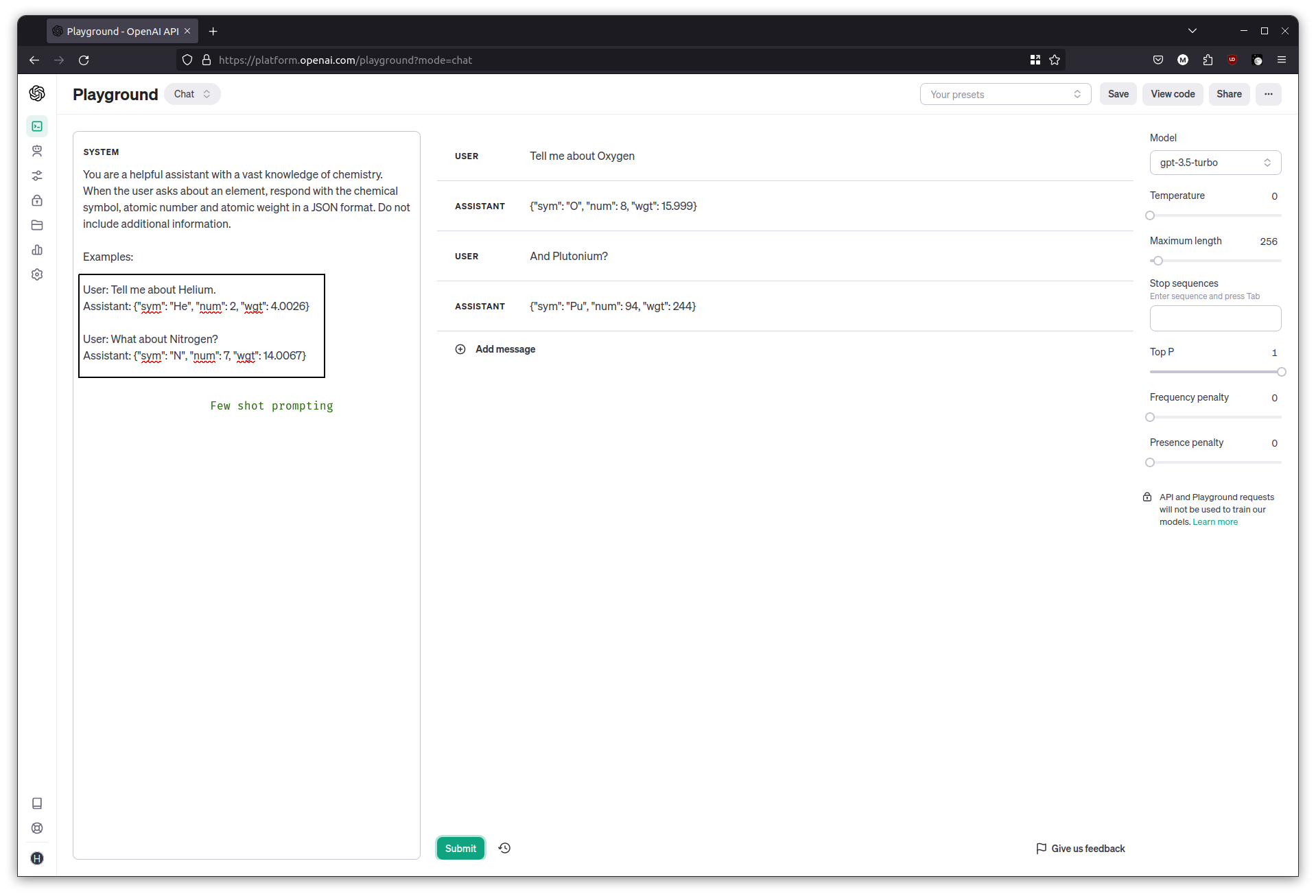
Programming with LangChain
LangChain is a framework that helps take away the heavy lifting when programming against LLMs including OpenAI, Bedrock and LLaMa. It’s useful for prototyping and learning because it takes away a lot of the boilerplate work that we’d normally do, it comes with some predefined templates, and the ability to ‘use’ tools. The general consensus, currently, is that it’s a great way to start, although for an actual production application a developer might want more control over the interaction, and end up doing it themselves. Either way, it’s a good place to start for a tutorial at least.
In the next few steps let’s repeat some of the above exercises, and then move on to more complex examples like agents and tools.
Once your Python notebook is ready, install langchain and openai in a cell.
! pip install langchain openaiInitialize an llm object, this will be used by all the modules going forward. Have an API key ready, which can be generated here for OpenAI. In Azure OpenAI, it is visible by clicking ‘View Code’.
from langchain.chat_models import ChatOpenAI
llm = ChatOpenAI(temperature=1, model="gpt-3.5-turbo", openai_api_key="xxxxxxxxxxxxxxxxx")Here I’m telling it to use the GPT 3.5 Turbo model, with a temperature of 1.
Basic completion
Perform a basic completion now, just as we did back in the Completion playground, but this time it’s through the llm object. Run the code a few times to get different outputs.
llm.predict("The sky is")
#
# Output:
# 'The sky is the atmosphere above the Earth's surface. It is typically blue during the day due to sunlight scattering off particles in the atmosphere. At night, the sky appears black and is filled with stars, planets, and other celestial objects. The sky can also change colors, such as during sunrise and sunset when it can also appear orange, pink, or purple.'
# 'blue.'
# 'blue during the day and black during the night.'Summarizing text
Set the temperature to 0.1 for the llm object, as we need increased predictability for the rest of the exercises.
from langchain.chat_models import ChatOpenAI
llm = ChatOpenAI(temperature=0.1, model="gpt-3.5-turbo", openai_api_key="xxxxxxxxxxxxxxxxx")In another cell, copy the body text from a news article, and have the LLM summarize it.
text = """
Summarize the following news article in one paragraph.
<paste the news article here>
"""
llm.predict(text)
#
# I used the body from https://www.airseychelles.com/en/about-us/news/2021/07/air-seychelles-welcomes-appointment-new-acting-ceo-and-cfo
# Output:
# Air Seychelles has appointed Sandy Benoiton as its permanent chief executive after he served in the role on an interim basis. Benoiton has been with Air Seychelles for over 23 years, primarily as the airline's chief operations officer. The company recently announced profits of $8.4 million for 2022, marking its first positive annual result since 2016. As part of its recovery process, the airline entered administration and significantly reduced its debt levels. Air Seychelles operates a fleet of two Airbus A320 and five De Havilland Canada Dash 6 aircraft.Answering questions
As before, but programmatically. Supply a news article and a question for the LLM to answer. Grab a news article and ask a question.
text = """
Given this news article answer the question that follows.
<paste the news article here>
---
Question: What are the best locations to see the asteroid?"""
llm.predict(text)
# Output:
# The best locations to see the asteroid are along a corridor from central Asia and southern Europe to Florida and Mexico.Rudimentary chat interface
Recall the main attributes of a chatbot, mainly that it stops after an answer, and that it has some history so it knows what’s been asked before.
On its own, the basic llm object declared above is only useful for completion. To illustrate this, run the following in a cell, which creates an inline textbox.
Give it a statement (My favourite colour is green), then a follow up question (What is my favourite colour?), and watch it fail.
chat = ""
while(True):
if chat=="exit":
break
chat=input()
print(llm.predict(chat))
#
# My favorite colour is green.
# That's great! Green is a vibrant and refreshing color often associated with nature, growth, and harmony. It can also symbolize balance and renewal. What do you like most about the color green?
# What is my favorite colour?
# I'm sorry, but as an AI, I don't have access to personal information about individuals unless it has been shared with me during our conversation. Therefore, I don't know what your favorite color is. 
llm object doesn’t remember thingsIn order to give the LLM memory, we need to supply the previous questions and answers to the LLM as an input, followed by the user’s next question. We could build this up ourselves, but LangChain comes with built in helpers to do this for us.
LangChain comes with a helpful wrapper class, ConversationChain, which takes care of storing and sending previous conversations. It has the ability to store conversations in data stores, of which one is the in-memory ConversationBufferMemory. There are other options for backing stores for history, in-memory is the simplest for a tutorial. Create the conversation chain now:
from langchain.chains import ConversationChain
from langchain.memory import ConversationBufferMemory
conversation = ConversationChain(llm=llm, memory=ConversationBufferMemory(), verbose=True)Before running it though, have a look at the prompt template to see what it’s doing behind the scenes.
print(conversation.prompt.template)The template looks like this:
The following is a friendly conversation between a human and an AI. The AI is talkative and provides lots of specific details from its context. If the AI does not know the answer to a question, it truthfully says it does not know.
Current conversation:
{history}
Human: {input}
AI:
The {input} is where the user’s input goes, and the {history} is where the ConversationChain puts the previous conversation.
To see it in action, send a few questions using the conversation chain. Because we’ve set verbose=True above, we should also see the template being filled.
print(conversation.run("My favorite color is green"))
print(conversation.run("What is my favorite color?"))
You can now try the same ‘inline’ chatbot as before, but using the wrapper class with a memory buffer.
conversation = ConversationChain(llm=llm, memory=ConversationBufferMemory(), )
loop=True
chat=""
while(loop):
if chat=="exit":
break
else:
chat=input()
print(conversation.run(chat))
Run it, and have a conversation with the LLM! Ask it follow up questions to ensure that the history is being passed, and it’s paying attention to previous statements.

You have now built a rudimentary chatbot.
Shaped responses with few-shot examples
We can now try another shaped response by providing a few samples to the LLM. We provide LangChain with a role, a few examples, and then the user input so that it does exactly what we ask of it.
We’ll create an assistant that can help with the Linux commandline. Define the system prompt (role),
from langchain import LLMChain
from langchain.prompts.chat import (
ChatPromptTemplate,
SystemMessagePromptTemplate,
AIMessagePromptTemplate,
HumanMessagePromptTemplate,
)
system_message_prompt = SystemMessagePromptTemplate.from_template("You are a helpful assistant that outputs example Linux commands.I will describe what I want to do, and you will reply with a Linux command to accomplish that task. I want you to only reply with the Linux Bash command, and nothing else. Do not write explanations. Only output the command. If you don't have a Linux command to respond with, say you don't know, in an echo command")Build a few examples, showing a human description followed by what the LLM should output
example_human_1 = HumanMessagePromptTemplate.from_template("List files in the current directory")
example_ai_1 = AIMessagePromptTemplate.from_template("\nls\n")
example_human_2 = HumanMessagePromptTemplate.from_template("Push my git branch up")
example_ai_2 = AIMessagePromptTemplate.from_template("\ngit push origin <branchname>\n")
example_human_3 = HumanMessagePromptTemplate.from_template("What is your name?")
example_ai_3 = AIMessagePromptTemplate.from_template("\necho Sorry, I don't know a bash command for that.\n")Create the human prompt template, which is very straightforward in this case.
human_template = "\n{text}\n"
human_message_prompt = HumanMessagePromptTemplate.from_template(human_template)Finally bring them together into a LangChain “chain”.
chat_prompt = ChatPromptTemplate.from_messages(
[system_message_prompt, example_human_1, example_ai_1, example_human_2, example_ai_2, example_human_3, example_ai_3, human_message_prompt]
)
chain = LLMChain(llm=llm, prompt=chat_prompt, verbose=True)You can now try asking it for some Linux help.
print(chain.run("How to download a file from a URL?"))
print(chain.run("Which Linux distro am I running?"))Since verbose is set to True, you should see the formatted examples being sent before the user’s own question.

This is pretty much what I’m doing for my own LLM CLI Helper. One additional improvement, is that I include a few of the previous questions and answers that I had asked the LLM. This history helps set up additional context, and lets me ask follow up questions, and makes the helper feel more natural.

Providing tools to the LLM
If we were to ask the LLM to summarize the contents of the news article at a URL, without giving it the actual contents, it could still generate a summary by guessing from the URL’s words. LLMs on their own don’t have the ability to crawl web pages. This is where tools come in; we can let the LLM know what our own code has the ability to fetch web pages, all the LLM has to do is invoke it if needed.
In this exercise we’ll create a LangChain Tool that can fetch a web page and return its contents. We’ll pass that tool to the LLM, then ask it to summarize the contents of a URL.
To begin, install the BeautifulSoup4 library which will be used to parse HTML content.
! pip install beautifulsoup4Define a normal Python function that will crawl a given URL and fetch its contents.
import requests
from bs4 import BeautifulSoup
def get_content_from_url(url):
headers={'User-Agent': 'Mozilla/5.0 (X11; Linux x86_64; rv:10.0) Gecko/20100101 Firefox/10.0'}
response = requests.get(url, headers=headers)
soup = BeautifulSoup(response.text, "html.parser")
return soup.find('body').text
Do a quick test to make sure it’s working, by fetching a URL
print(get_content_from_url('https://www.universetoday.com/164299/an-asteroid-will-occult-betelgeuse-on-december-12th/'))We now create a LangChain Tool wrapper and give it a description. This will help the LLM understand what the tool can do.
from langchain.tools import Tool
fetch_tool = Tool(name="get_content_from_page",
func=get_content_from_url, coroutine=get_content_from_url,
description="Useful for when you need to get the contents of a web page")Finally, initialize a LangChain Agent, passing it the Tool defined above.
from langchain.agents import AgentType, initialize_agent
agent = initialize_agent(
[fetch_tool], llm, agent=AgentType.ZERO_SHOT_REACT_DESCRIPTION, verbose=True, handle_parsing_errors=True
)This creates a LangChain Agent, another useful wrapper in the framework. An ‘Agent’, in LLM terms, is a fancy way of saying that it has the ability to make use of tools, thereby giving it ‘agency’. Technically speaking the LLM does not invoke anything, it simply outputs that it needs to call a certain tool; LangChain takes care of invoking it and returning the result to the LLM so that it can proceed with its reasoning.
You can have a look at the template being used by LangChain to inform the LLM about the tool.
agent.to_json()['repr']A bit of squinting at the dense output should show the template, including our supplied get_content_from_page tool.
template='Answer the following questions as best you can. You have access to the following tools:
get_content_from_page: Useful for when you need to get the contents of a web page <------- There!
Use the following format:
Question: the input question you must answer
Thought: you should always think about what to do
Action: the action to take, should be one of [get_content_from_page]
Action Input: the input to the action
Observation: the result of the action
... (this Thought/Action/Action Input/Observation can repeat N times)
Thought: I now know the final answer
Final Answer: the final answer to the original input question
Begin!
Question: {input}
Thought:{agent_scratchpad}'
We can now ask the LLM to summarize the contents of a page.
agent.run("Please fetch and summarize the contents of this page: https://code.mendhak.com/in-appreciation-of-fdroid/")Watch the output as the LLM, in its chain of thought process, figures out it needs to invoke the tool; LangChain picks up on that and does the actual invocation and passes the results back. The LLM then proceeds to summarize the contents.

Try it with a few more URLs. It is not uncommon for the agent to sometimes fall over and get into a loop (use the stop button next to the cell when this happens). The agent isn’t perfect and can get confused at times.
Question answering over documents
Although LLMs are trained by crawling over web content, even over trillions of tokens they don’t have all the answers. This is especially true for documents or datasets that are specific to businesses and individuals, which the LLM will not have had access to.
If we want an LLM to answer a question over a specific datset or document store with certainty, we would need to provide those documents to the LLM as part of its context. However, even with 100k+ token LLMs, this isn’t feasible if there are lots of documents. The LLM will either lose attention or the large number of documents just won’t fit.
Instead, the answer is to use something called Retrieval Augmented Generation (RAG). We first take all our documents and convert them into embeddings, and store them. When a user asks a question, we match the user’s question with the closest set of documents that are probably related to that question. We then grab that document and pass it to the LLM along with the user’s question, to get a natural looking answer. The LLM only has to work with relevant documents to answer the question.
In other words, Retrieval Augmented Generation is just a fancy phrasing for picking out most relevant documents before giving it to the LLM.
Let’s briefly look at RAG and embeddings, before doing a basic example in code.
How RAG works
- We first take each dataset or document, and pass it to an embedding model, which is a way of converting the text into a special numerical representation optimized for natural language searching.
- Once we have these embeddings, we store them in a vector store, a database that’s optimized for searching over embeddings.
- When a user asks a question, we take their question and pass it to the same embedding model.
- We use the vector store to search for the documents that most likely match that user’s question. This is where embeddings shine as they are good at matching natural language documents together.
- Once we have a document matching the user’s question, we pass the document and the user’s question to the LLM, to generate a natural looking response.

How embeddings work
Embeddings are a special way of representing words, by placing similar terms close to each other.
A good way to visualize it is with this image below.

You can have words like “king” and “queen” close to each other in the “male-female” dimension.
You can have “swam” and “swimming” close to each other in the “verb-tense” dimension.
You can have “Japan” and “Tokyo” close to each other in the “country-capital” dimension.
These are just examples of words close to each other, but in just one dimension. An embedding is a vector that represents words close to each other across hundreds or thousands of dimensions. Embedding models have strong opinions of which kinds of words should be located near each other in such a space. By producing these numerical representations, they make it easy to search for similarity.
Retrieval Augmented Search with LangChain
In a cell, use LangChain’s WebBaseLoader to load three URLs. We will eventually ask a question that is answered in one of these pages.
# Document loading
from langchain.document_loaders import WebBaseLoader
urls = [
"https://www.cirium.com/thoughtcloud/aviation-analytics-on-the-fly-london-busiest-overseas-airline-markets/",
"https://www.cirium.com/thoughtcloud/summer-in-spain-airline-market/",
"https://www.cirium.com/thoughtcloud/analysis-china-slower-post-pandemic-aviation-recovery/",
]
loader = WebBaseLoader(urls)
data = loader.load()All this does so far is fetch the text from these pages. Have a peek inside by running data in a cell.
dataSplit up the documents
We now need to split these documents into chunks for embedding and vector storage. I’ve arbitrarily chosen 500 as the chunk size.
# Splitting the documents into chunks for embedding and vector storage
from langchain.text_splitter import RecursiveCharacterTextSplitter
text_splitter = RecursiveCharacterTextSplitter(chunk_size = 500, chunk_overlap = 0)
documents = text_splitter.split_documents(data)At this point, documents contains the same content from before, just split up, but with references to the original URLs. Have a peek.
documents[:5]Set up the embedding model
The document chunks will need to be passed to an embedding model. The text can’t just be passed as-is, it needs to be tokenized first.
Install the tiktoken library.
! pip install tiktokenInitialize an OpenAIEmbeddings object with the same OpenAI API key. We’ll use an OpenAI model called text-embedding-ada-002 to create embeddings.
# Initialize Embeddings object to use ADA 002 on OpenAI
from langchain.embeddings import OpenAIEmbeddings
embeddings = OpenAIEmbeddings(openai_api_key="xxxxxxxxxxxxxxxxx", model="text-embedding-ada-002")What does an embedding actually look like?
You can do a little test to see what an embedding looks like.
test_embedding = embeddings.embed_query("The quick brown fox jumps over the lazy little dogs")Have a look at the contents of test_embedding, it’s a large array of numbers.
print(test_embedding)An interesting note, if we look at its length, the value is always the same, no matter what text we passed to the embedding model. In the case of ADA 002 model, the value is 1536, which is the number of dimensions (relationships as discussed earlier) that the model represents its tokens in.
len(test_embedding)
Convert the documents to embeddings and store them
This step is pretty simple, for once. Using the documents built earlier, we use the FAISS library to build an in memory vector store, using the embeddings object and calling OpenAI’s ADA 002 model.
Install FAISSp
!pip install faiss-cpuAnd then run the conversion.
db = FAISS.from_documents(documents, embeddings)Do the search
At this point, the db is queryable, and we can get a preview of what a similarity search would look like. Try asking the question:
db.similarity_search_with_score("Where did EasyJet cut capacity?")
The question Where did EasyJet cut capacity? will have been converted to an embedding, and a similarity search performed across the in memory vector store.
It does manage to find a relevant set of passages with some scores. But keep in mind that its similarity search will only find the most relevant chunk that was stored, not the entire document.
This is where LangChain comes in with another convenience wrapper. We pass the above vector store, along with the user’s question to a RetrievalQAWithSourcesChain. LangChain uses the retriever to perform the search (as we’ve tested briefly above), figures out the relevant documents based on score, passes it to the llm along with the question, and returns an answer with the source document.
# Ask a question and retrieve the most likely document
retriever = db.as_retriever()
chain = RetrievalQAWithSourcesChain.from_chain_type(llm=llm, chain_type="stuff", retriever=retriever, return_source_documents=True, verbose=True)
result = chain({"question": "Where did EasyJet cut capacity?"})
print(result["answer"], "Source: ", result["sources"])
The template that LangChain uses to instruct the LLM is simple though verbose. Have a look at it:
chain.combine_documents_chain.llm_chain.prompt.templateThe only LLM related step here was at the end, where the user’s question was answered based off a found document. The actual work happened in the storing and searching of the vector store.
Because embeddings and vector storage are more cost-effective than working with LLMs, it could become a regular fixture in businesses ecosystems. Postgres is a popular database in many tech stacks, and it has a vector search extension called pgvector. Having regular data alongside embeddings in the same transactional database is very attractive for people who want to keep a small maintenance footprint.
One pitfall however is that the embeddings produced are specific to the embedding model used. In our example, if OpenAI ever removed ADA 002, then the embeddings would need to be performed again for every document.
Where to learn more
Hopefully this tutorial has demystified LLMs and unearthed some of the loose (almost frighteningly so) techniques that go behind LLM based applications.
For more about LangChain, I found it useful to go through their docs and just tackle each example, especially the ones under agents and tools. That said, keep in mind that LangChain still feels like in its ‘early days’ and its skyrocketing popularity and attention has not done it any favors.
The Prompt Engineering Guide site is a good catalog of the various techniques used by applications to coerce LLMs to give the right kind of response. These techniques will be useful regardless of how you interact with the LLMs.
OpenAI’s offerings don’t have to be the only commercial one you use, Anthropic’s Claude is also pretty good, and comes with its own guide and they also tell you how their prompts differ from GPT’s prompts. Claude is available directly via their site, or via Amazon Bedrock. From experience though, I’ve found that LangChain only partially integrates with Bedrock/Claude, and its OpenAI centric templates don’t always work with other LLMs. Some important differences are that Claude is best suited to work with XML in its instructions, examples, and output, and further, it’s best to place the question towards the end of your prompt, not the beginning.
LLMs for personal use
Although this tutorial is mostly centered around OpenAI which is a closed, hosted, commercial LLMs, it’s also possible to make use of local LLMs running on your computer. It’s entirely offline and private, so the only cost is your own hardware and electricity. Several models have been released, and it’s a pretty busy space as there’s so much activity.
Some examples of local LLMs are: LLaMa2, Stable Beluga and Mistral. There are a variety of ways to run them, and the best way to get started is with oobabooga/text-generation-webui.
You can also run via commandline and Docker with Ollama and Python bindings for llama.cpp. I was even able to get LLaMa2 running on my phone.
Programmatic interaction with LangChain makes use of some of the above projects. It can talk to a local LLaMa2 model, but it’s worth noting that most of LangChain development is centered around OpenAI, so they tend to be slower to fix issues or introduce features for other platforms including LLaMa2 and even Amazon’s Bedrock.
Yet another way to run a local model is with vllm, which hosts the model behind an HTTP interface that is very similar to OpenAI’s own APIs. That means you can use OpenAI libraries to talk to local models.